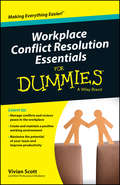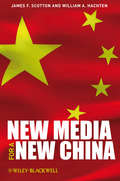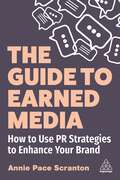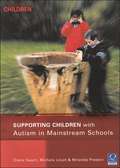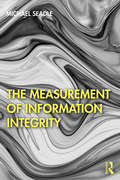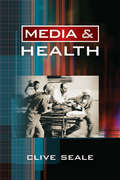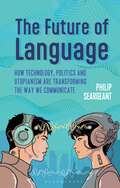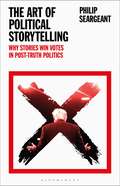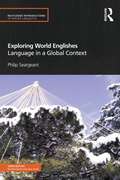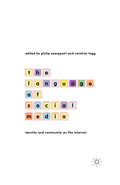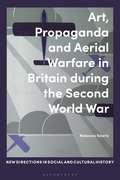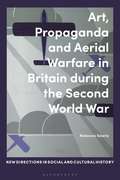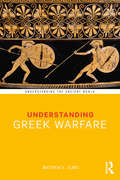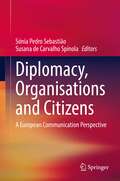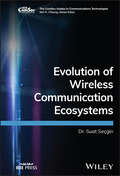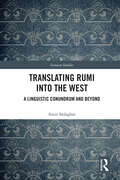- Table View
- List View
Workplace Conflict Resolution Essentials For Dummies (For Dummies)
by Vivian ScottResolving conflict in the workplace? No problem! Working your way through a conflict in the office can present unexpected challenges, but there's no need to feel unprepared — Workplace Conflict Resolution Essentials For Dummies has you covered! In the book, you'll find practical, expert guidance on various approaches to negotiating and mediating a successful resolution for you and your team. You'll get coverage of negotiation techniques, mediation methods and solutions for managers and employees dealing with workplace conflict, and tons of tips on building and maintaining successful teams to work through existing conflicts and help avoid future disturbances. Encouraging colleagues to work together toward a common goal is an essential skill that all successful business professionals must possess. Rather than resorting to arguments, surrendering, running away or filing a complaint, this resource shows you how to address uncomfortable conflict in the workplace head-on, giving you the tools and advice you need to restore peace, prevent conflicts from ever starting in the first place, and maintain better productivity while boosting morale. Offers clear instruction for addressing conflicts, resolving disputes and restoring peace and productivity to the workplace Helps you find a solution and explore positive means for resolving conflicts Illustrates how working through problems within your team makes the workplace the positive environment it should be Provides guidance on developing the key negotiation and mediation skills you need to create a harmonious workplace Whether you're new to managing professionals, working your way up the corporate ladder or just want to brush up on your knowledge base, Workplace Conflict Resolution Essentials For Dummies has everything you need to ensure your workplace environment is positive and productive!
Workplace Conflict Resolution Essentials For Dummies
by Vivian ScottResolving conflict in the workplace? No problem! Working your way through a conflict in the office can present unexpected challenges, but there's no need to feel unprepared — Workplace Conflict Resolution Essentials For Dummies has you covered! In the book, you'll find practical, expert guidance on various approaches to negotiating and mediating a successful resolution for you and your team. You'll get coverage of negotiation techniques, mediation methods and solutions for managers and employees dealing with workplace conflict, and tons of tips on building and maintaining successful teams to work through existing conflicts and help avoid future disturbances. Encouraging colleagues to work together toward a common goal is an essential skill that all successful business professionals must possess. Rather than resorting to arguments, surrendering, running away or filing a complaint, this resource shows you how to address uncomfortable conflict in the workplace head-on, giving you the tools and advice you need to restore peace, prevent conflicts from ever starting in the first place, and maintain better productivity while boosting morale. Offers clear instruction for addressing conflicts, resolving disputes and restoring peace and productivity to the workplace Helps you find a solution and explore positive means for resolving conflicts Illustrates how working through problems within your team makes the workplace the positive environment it should be Provides guidance on developing the key negotiation and mediation skills you need to create a harmonious workplace Whether you're new to managing professionals, working your way up the corporate ladder or just want to brush up on your knowledge base, Workplace Conflict Resolution Essentials For Dummies has everything you need to ensure your workplace environment is positive and productive!
New Media for a New China
by James F. Scotton William A. HachtenNew Media for a New China is a timely introduction to the current state of the mass media in China and it’s growing role in the 21st Century global communication system Brings together an international cast of scholars to analyse the diverse roles of China’s media, covering all the major industries (advertising, newspapers, broadcasting, magazines, film, TV, PR) Considers the position of China’s media in the middle of the country’s tremendous social, economic and political changes Explores the concept of the 21st century as “China’s Century” because of the nation’s unprecedented growth
The Guide to Earned Media: How to Use PR Strategies to Enhance Your Brand
by Annie Pace ScrantonHarness the power of public relations and discover how you can secure meaningful press for your organization.It can be difficult to publicize a company or a product without formal training, yet it's more important than ever for successful marketing strategies to include media relations. In this book, media expert Annie Pace Scranton breaks down the most powerful and efficient PR tactics that brands can use to garner the right kind of attention. The book guides marketing and PR professionals through the process of developing authentic messaging, unique selling points, timely news pitches and other engaging ways to reach the media.The Guide to Earned Media is a must-read for anyone ready to unleash the power of public relations, perfect their messaging and work toward long-term brand prominence. Readers will walk away knowing how to make use of the most effective media strategies available today.
The Guide to Earned Media: How to Use PR Strategies to Enhance Your Brand
by Annie Pace ScrantonHarness the power of public relations and discover how you can secure meaningful press for your organization.It can be difficult to publicize a company or a product without formal training, yet it's more important than ever for successful marketing strategies to include media relations. In this book, media expert Annie Pace Scranton breaks down the most powerful and efficient PR tactics that brands can use to garner the right kind of attention. The book guides marketing and PR professionals through the process of developing authentic messaging, unique selling points, timely news pitches and other engaging ways to reach the media.The Guide to Earned Media is a must-read for anyone ready to unleash the power of public relations, perfect their messaging and work toward long-term brand prominence. Readers will walk away knowing how to make use of the most effective media strategies available today.
Supporting Children with Autism in Mainstream Schools (Supporting Children)
by Diana Seach Michele Lloyd Miranda PrestonIt is increasingly common for children with autism to attend mainstream schools. In this book, the authors use their expertise and considerable experience of working with and observing pupils with autism to exemplify the challenges faced in the classroom. Most importantly, they suggest practical strategies for successfully meeting pupil's learning needs. The case studies bring to life the everyday concerns of young people, their parents and teachers, and provide different contexts for the demonstration of good practice.
The Measurement of Information Integrity
by Michael SeadleArguing that there never was a time when politicians did not prevaricate and when some communities did not doubt conclusions that others considered to be facts, The Measurement of Information Integrity puts the post-truth era in context and offers measures for integrity in the modern world. Incorporating international examples from a range of disciplines, this book provides the reader with tools that will help them to evaluate public statements - especially ones involving the sciences and scholarship. It also provides intellectual tools to those who must assess potential violations of public or academic integrity. Many of these tools involve measurement mechanisms, ways of putting cases into context, and a recognition that few cases are simple black-and-white violations. Demonstrating that a binary approach to judging research integrity fails to recognize the complexity of the environment, Seadle highlights that even flawed discoveries may still contain value. Finally, the book reminds its reader that research integrity takes different forms in different disciplines and that each one needs separate consideration, even if the general principles remain the same for all. The Measurement of Information Integrity will help those who want to do research well, as well as those who must ascertain whether results have failed to meet the standards of the community. It will be of particular interest to researchers and students engaged in the study of library and information science.
The Measurement of Information Integrity
by Michael SeadleArguing that there never was a time when politicians did not prevaricate and when some communities did not doubt conclusions that others considered to be facts, The Measurement of Information Integrity puts the post-truth era in context and offers measures for integrity in the modern world. Incorporating international examples from a range of disciplines, this book provides the reader with tools that will help them to evaluate public statements - especially ones involving the sciences and scholarship. It also provides intellectual tools to those who must assess potential violations of public or academic integrity. Many of these tools involve measurement mechanisms, ways of putting cases into context, and a recognition that few cases are simple black-and-white violations. Demonstrating that a binary approach to judging research integrity fails to recognize the complexity of the environment, Seadle highlights that even flawed discoveries may still contain value. Finally, the book reminds its reader that research integrity takes different forms in different disciplines and that each one needs separate consideration, even if the general principles remain the same for all. The Measurement of Information Integrity will help those who want to do research well, as well as those who must ascertain whether results have failed to meet the standards of the community. It will be of particular interest to researchers and students engaged in the study of library and information science.
Media and Health
by Clive Seale`This book appears to fill a substantial gap in the literature at present. There are, quite simply, no books available which engage seriously and competently with the presentation of health issues in the media, and certainly none which focuses on representations of health and illness in as thematically coherent a manner as Seale proposes to do' - Richard Gwyn, University of Cardiff `This is an excellent resource for students. It provides a comprehensive review of secondary literature in the field and is very well researched. Students of sociology of health and illness and in media and communication studies will find the book invaluable' - David Oswell, Goldsmiths College, University of London `This is a comprehensive work on media health, providing an invaluable "toolkit" for understanding health and the media in contemporary society. Seale goes further than previous textbooks, critiquing the "lament" of media health promoters in order to explore the moralisation and commercialisation of media health' - Dr Annette Hill, University of Westminster How are health matters presented by the mass media? How accurate are the messages we are receiving? This book demonstrates how health messages in popular mass media are important influences in our lives, and that they are not neutral, being subject to many determining influences. It demonstrates the importance of mass media for understanding the experience of illness, health and health care, bringing together the latest thinking in the field of media studies and the sociology of health and illness. This book provides a thorough review of research literature on media representations of health, illness and health care, covering their production, characteristic forms and relationships with the everyday lives of media audiences. It brings together both well known and lesser-known studies in the context of an integrated, sociological argument about media and health. Media producers are subject to a variety of influences, from medical lobbies, scientific organizations, and not least the commercial pressure to satisfy media-saturated audiences. These mean that aims of health promoters are not always easily achieved, leading to considerable tensions that require a deeper understanding of media health than has hitherto been applied to them. This book will be essential reading for health educators and promoters, as well as health care providers interested in the cultural aspects of health, sociologists of health and illness, and students and academics of media studies.
Media and Health (PDF)
by Clive Seale`This book appears to fill a substantial gap in the literature at present. There are, quite simply, no books available which engage seriously and competently with the presentation of health issues in the media, and certainly none which focuses on representations of health and illness in as thematically coherent a manner as Seale proposes to do' - Richard Gwyn, University of Cardiff `This is an excellent resource for students. It provides a comprehensive review of secondary literature in the field and is very well researched. Students of sociology of health and illness and in media and communication studies will find the book invaluable' - David Oswell, Goldsmiths College, University of London `This is a comprehensive work on media health, providing an invaluable "toolkit" for understanding health and the media in contemporary society. Seale goes further than previous textbooks, critiquing the "lament" of media health promoters in order to explore the moralisation and commercialisation of media health' - Dr Annette Hill, University of Westminster How are health matters presented by the mass media? How accurate are the messages we are receiving? This book demonstrates how health messages in popular mass media are important influences in our lives, and that they are not neutral, being subject to many determining influences. It demonstrates the importance of mass media for understanding the experience of illness, health and health care, bringing together the latest thinking in the field of media studies and the sociology of health and illness. This book provides a thorough review of research literature on media representations of health, illness and health care, covering their production, characteristic forms and relationships with the everyday lives of media audiences. It brings together both well known and lesser-known studies in the context of an integrated, sociological argument about media and health. Media producers are subject to a variety of influences, from medical lobbies, scientific organizations, and not least the commercial pressure to satisfy media-saturated audiences. These mean that aims of health promoters are not always easily achieved, leading to considerable tensions that require a deeper understanding of media health than has hitherto been applied to them. This book will be essential reading for health educators and promoters, as well as health care providers interested in the cultural aspects of health, sociologists of health and illness, and students and academics of media studies.
The Future of Language: How Technology, Politics and Utopianism are Transforming the Way we Communicate
by Dr Philip SeargeantWill language as we know it cease to exist? What could this mean for the way we live our lives?Shining a light on the technology currently being developed to revolutionise communication, The Future of Language distinguishes myth from reality and superstition from scientifically-based prediction as it plots out the importance of language and raises questions about its future. From the rise of artificial intelligence and speaking robots, to brain implants andcomputer-facilitated telepathy, language and communications expert Philip Seargeant surveys the development of new digital 'languages', such as emojis, animated gifs and memes, and investigates how conventions of spoken and written language are being modified by new trends in communication. From George Orwell's fictional predictions in Nineteen Eighty-Four to the very real warnings of climate activist Greta Thunberg, Seargeant explores language through time, traversing politics, religion, philosophy, literature, and of course technology, in the process. Tracing how previous eras have imagined the future of language, from the Bible to the works H. G. Wells, and from Star Wars to Star Trek, the book reveals how perfecting language and communication has always been a vital component of utopian dreams of the future. Questioning the potential ramifications of recent and future developments in communication on society and its ideals, The Future of Language is a no holds barred investigation into the state of civilisation and the impact that changes in language could have on our lives.
The Future of Language: How Technology, Politics and Utopianism are Transforming the Way we Communicate
by Dr Philip SeargeantWill language as we know it cease to exist? What could this mean for the way we live our lives?Shining a light on the technology currently being developed to revolutionise communication, The Future of Language distinguishes myth from reality and superstition from scientifically-based prediction as it plots out the importance of language and raises questions about its future. From the rise of artificial intelligence and speaking robots, to brain implants andcomputer-facilitated telepathy, language and communications expert Philip Seargeant surveys the development of new digital 'languages', such as emojis, animated gifs and memes, and investigates how conventions of spoken and written language are being modified by new trends in communication. From George Orwell's fictional predictions in Nineteen Eighty-Four to the very real warnings of climate activist Greta Thunberg, Seargeant explores language through time, traversing politics, religion, philosophy, literature, and of course technology, in the process. Tracing how previous eras have imagined the future of language, from the Bible to the works H. G. Wells, and from Star Wars to Star Trek, the book reveals how perfecting language and communication has always been a vital component of utopian dreams of the future. Questioning the potential ramifications of recent and future developments in communication on society and its ideals, The Future of Language is a no holds barred investigation into the state of civilisation and the impact that changes in language could have on our lives.
The Art of Political Storytelling: Why Stories Win Votes in Post-truth Politics
by Philip SeargeantIn our post-truth world, tapping into people's emotions has proved far more effective than rational argument - and, as Philip Seargeant argues in this illuminating and entertaining book, the most powerful tool for manipulating emotions is a gripping narrative. From Trump's America to Brexit Britain, weaving a good story, featuring fearless protagonists, challenging quests against seemingly insurmountable odds, and soundbite after soundbite of memorable dialogue has been at the heart of political success. So does an understanding of the art of storytelling help explain today's successful political movements? Can it translate into a blueprint for victory at the ballot box?The Art of Political Storytelling looks at how stories are created, shared and contested, illuminating the pivotal role that persuasive storytelling plays in shaping our understanding of the political world we live in. By mastering the tools and tricks of narrative, and evaluating the language and rhetorical strategies used to craft and enact them, Seargeant explains how and why today's combination of new media, populism and partisanship makes storytelling an ever more important part of the persuasive and political process. In doing so, the book offers an original and compelling way of understanding the chaotic world of today's politics.
The Art of Political Storytelling: Why Stories Win Votes in Post-truth Politics
by Philip SeargeantIn our post-truth world, tapping into people's emotions has proved far more effective than rational argument - and, as Philip Seargeant argues in this illuminating and entertaining book, the most powerful tool for manipulating emotions is a gripping narrative. From Trump's America to Brexit Britain, weaving a good story, featuring fearless protagonists, challenging quests against seemingly insurmountable odds, and soundbite after soundbite of memorable dialogue has been at the heart of political success. So does an understanding of the art of storytelling help explain today's successful political movements? Can it translate into a blueprint for victory at the ballot box?The Art of Political Storytelling looks at how stories are created, shared and contested, illuminating the pivotal role that persuasive storytelling plays in shaping our understanding of the political world we live in. By mastering the tools and tricks of narrative, and evaluating the language and rhetorical strategies used to craft and enact them, Seargeant explains how and why today's combination of new media, populism and partisanship makes storytelling an ever more important part of the persuasive and political process. In doing so, the book offers an original and compelling way of understanding the chaotic world of today's politics.
Exploring World Englishes: Language In A Global Context (PDF)
by Philip SeargeantRoutledge Introductions to Applied Linguisticsis a series of introductory level textbooks covering the core topics in Applied Linguistics, primarily designed for those beginning postgraduate studies, or taking an introductory MA course as well as advanced undergraduates. Titles in the series are also ideal for language professionals returning to academic study. The books take an innovative 'practice to theory' approach, with a 'back-to-front' structure. This leads the reader from real-world problems and issues, through a discussion of intervention and how to engage with these concerns, before finally relating these practical issues to theoretical foundations. Additional features include tasks with commentaries, a glossary of key terms, and an annotated further reading section. In this book Philip Seargeant surveys varieties of English existing within the world today, and the debates and controversies surrounding its present forms, functions and status in diverse world contexts. It examines how English has evolved to become a 'global language' and looks at the political and cultural history that has influenced this evolution. Beginning with a discussion of real-life challenges relating to world Englishes that are faced by language professionals - particularly in the contexts of language education and language planning - the book explores and illustrates the ways in which the actual use and management of English, as well as the beliefs and ideologies associated with it, play an increasingly important role in contemporary globalized society.
Exploring World Englishes: Language In A Global Context
by Philip SeargeantRoutledge Introductions to Applied Linguisticsis a series of introductory level textbooks covering the core topics in Applied Linguistics, primarily designed for those beginning postgraduate studies, or taking an introductory MA course as well as advanced undergraduates. Titles in the series are also ideal for language professionals returning to academic study. The books take an innovative 'practice to theory' approach, with a 'back-to-front' structure. This leads the reader from real-world problems and issues, through a discussion of intervention and how to engage with these concerns, before finally relating these practical issues to theoretical foundations. Additional features include tasks with commentaries, a glossary of key terms, and an annotated further reading section. In this book Philip Seargeant surveys varieties of English existing within the world today, and the debates and controversies surrounding its present forms, functions and status in diverse world contexts. It examines how English has evolved to become a 'global language' and looks at the political and cultural history that has influenced this evolution. Beginning with a discussion of real-life challenges relating to world Englishes that are faced by language professionals - particularly in the contexts of language education and language planning - the book explores and illustrates the ways in which the actual use and management of English, as well as the beliefs and ideologies associated with it, play an increasingly important role in contemporary globalized society.
The Language of Social Media: Identity and Community on the Internet
by Philip Seargeant Caroline TaggThis timely book examines language on social media sites including Facebook and Twitter. Studies from leading language researchers, and experts on social media, explore how social media is having an impact on how we relate to each other, the communities we live in, and the way we present a sense of self in twenty-first century society.
Art, Propaganda and Aerial Warfare in Britain during the Second World War (New Directions in Social and Cultural History)
by Rebecca SearleThe War Artists' Advisory Committee (WAAC) were responsible for the production of some of the most iconic images of the Second World War. Despite its rich historical value, this collection has been poorly utilised by historians and hasn't been subjected to the levels of analysis afforded to other forms of wartime culture. This innovative study addresses this gap by bringing official war art into dialogue with the social, economic and military histories of the Second World War. Rebecca Searle explores the tensions between the documentarist and propagandistic roles of the WAAC in their representation of aerial warfare in the battle for production, the Battle of Britain, the Blitz and the bombing of Germany. Her analyses demonstrate that whilst there was a strong correlation between war art and propaganda, the WAAC depicted many aspects of experience that were absent from wartime propaganda, such as class divisions within the services, gendered hierarchies within industries, civilian death and the true nature of the bombing of Germany. In addition, she shows that propagandistic constructions were not entirely separate from lived experience, but reflected experience and shaped the way that individuals made sense of the war. Accessibly written, highly illustrated and packed with valuable examples of the use of war art as historical source, this book will enhance our understanding of the social and cultural history of Britain during the Second World War.
Art, Propaganda and Aerial Warfare in Britain during the Second World War (New Directions in Social and Cultural History)
by Rebecca SearleThe War Artists' Advisory Committee (WAAC) were responsible for the production of some of the most iconic images of the Second World War. Despite its rich historical value, this collection has been poorly utilised by historians and hasn't been subjected to the levels of analysis afforded to other forms of wartime culture. This innovative study addresses this gap by bringing official war art into dialogue with the social, economic and military histories of the Second World War. Rebecca Searle explores the tensions between the documentarist and propagandistic roles of the WAAC in their representation of aerial warfare in the battle for production, the Battle of Britain, the Blitz and the bombing of Germany. Her analyses demonstrate that whilst there was a strong correlation between war art and propaganda, the WAAC depicted many aspects of experience that were absent from wartime propaganda, such as class divisions within the services, gendered hierarchies within industries, civilian death and the true nature of the bombing of Germany. In addition, she shows that propagandistic constructions were not entirely separate from lived experience, but reflected experience and shaped the way that individuals made sense of the war. Accessibly written, highly illustrated and packed with valuable examples of the use of war art as historical source, this book will enhance our understanding of the social and cultural history of Britain during the Second World War.
Understanding Greek Warfare (Understanding the Ancient World)
by Matthew A. SearsUnderstanding Greek Warfare offers a wide-ranging survey of Greek warfare, from the Mycenaeans through to the Hellenistic kingdoms’ clashes with Rome. Each chapter provides an overview of a particular theme and historical period, and a detailed discussion of the relevant sources, both ancient and modern. This volume covers not only the development of equipment, tactics, strategy, and the major wars of Greek history – the "drums and trumpets" – it also examines the political, social, and cultural importance of warfare in each period. Each chapter outlines major scholarly debates, such as the true nature of hoplite battle and whether Alexander the Great had a strategic vision beyond conquest, and includes several short selections from the primary literary evidence. Readable yet scholarly, this book is an ideal companion to courses on Greek warfare and society, and offers detailed suggestions for further reading and research. Understanding Greek Warfare will be a crucial resource for students of war in the ancient Greek world, and of the ancient Greeks in general.
Diplomacy, Organisations and Citizens: A European Communication Perspective
by Sónia Pedro Sebastião Susana de Carvalho SpínolaThis book uses an innovative interdisciplinary approach to explain how communication is a necessary condition for diplomacy in a digital and relationship-driven world. Divided into three parts, it highlights the importance of communication strategies and processes in contemporary society and in current global socio-political events in general, particularly within the field of diplomacy. The first part discusses the main theoretical debates that shaped the central concepts of the project, while the second part of the book presents further practical approaches and examples of diplomatic practice. Lastly, the third part focuses on pedagogical and methodological approaches, which can be useful in diplomacy and communication classes and for the implementation of a European curriculum. This interdisciplinary book will appeal to students, researchers, policy-makers, and practitioners from various disciplines, including international relations, political science, business, and communication.
Evolution of Wireless Communication Ecosystems (The ComSoc Guides to Communications Technologies)
by Suat SecginEvolution of Wireless Communication Ecosystems Understand a world transformed by wireless communication with this groundbreaking guide Since the advent of the internet, few technologies have proven more transformative than wireless communication. Never have we lived in a more comprehensively connected world, with the cloud and the coming sixth generation (6G) of wireless technology creating a vast and interconnected communications infrastructure. Global citizens of this newly interconnected reality are grappling like never before with its many challenges. Evolution of Wireless Communication Ecosystems provides readers with a history of wireless communication and a thorough overview of emerging frontiers. It traces wireless communication from the first generation through to the current fifth before surveying the current state of wireless technology and the ongoing research into 6G. The result is a book that understands wireless communication for the first time as an ecosystem, endlessly interconnected, growing, and boundlessly complex, but made intelligible by this highly readable introduction. Readers will also find: Detailed explanations of the journey starting from 1G to 6G Descriptions the infrastructure of 4G, 5G, and 6G systems, this all-connected communication ecosystem, the sub-components of this ecosystem, and the relationship among them Depictions of events seen in the capillaries of the communication echo system that show switching techniques, modulation, and multiplexing techniques Coverage of access techniques, protocols, the methods used in M2M and IoT connections at the endpoints, and security issues that show how they are an integral part of wireless communication infrastructure Evolution of Wireless Communication Ecosystems from 1G to 6G is an essential reference for wireless and telecommunications professionals, as well as researchers interested in 6G or other emerging wireless technologies.
Evolution of Wireless Communication Ecosystems (The ComSoc Guides to Communications Technologies)
by Suat SecginEvolution of Wireless Communication Ecosystems Understand a world transformed by wireless communication with this groundbreaking guide Since the advent of the internet, few technologies have proven more transformative than wireless communication. Never have we lived in a more comprehensively connected world, with the cloud and the coming sixth generation (6G) of wireless technology creating a vast and interconnected communications infrastructure. Global citizens of this newly interconnected reality are grappling like never before with its many challenges. Evolution of Wireless Communication Ecosystems provides readers with a history of wireless communication and a thorough overview of emerging frontiers. It traces wireless communication from the first generation through to the current fifth before surveying the current state of wireless technology and the ongoing research into 6G. The result is a book that understands wireless communication for the first time as an ecosystem, endlessly interconnected, growing, and boundlessly complex, but made intelligible by this highly readable introduction. Readers will also find: Detailed explanations of the journey starting from 1G to 6G Descriptions the infrastructure of 4G, 5G, and 6G systems, this all-connected communication ecosystem, the sub-components of this ecosystem, and the relationship among them Depictions of events seen in the capillaries of the communication echo system that show switching techniques, modulation, and multiplexing techniques Coverage of access techniques, protocols, the methods used in M2M and IoT connections at the endpoints, and security issues that show how they are an integral part of wireless communication infrastructure Evolution of Wireless Communication Ecosystems from 1G to 6G is an essential reference for wireless and telecommunications professionals, as well as researchers interested in 6G or other emerging wireless technologies.
Translating Rumi into the West: A Linguistic Conundrum and Beyond (Iranian Studies)
by Amir SedaghatFocusing on Rumi, the best-selling Persian mystical poet of the 13th century, this book investigates the reception of his work and thought in North America and Europe – and the phenomenon of ‘Rumimania’ – to elucidate the complexities of intercultural communication between the West and the Iranian and Islamic worlds. Presenting tens of examples from the original and translated texts, the book is a critical analysis of various dimensions of this reception, outlining the difficulties of translating the text but also exploring how translators of various times and languages have performed, and explaining why the quality of reception varies. Topics analysed include the linguistic and pragmatic issues of translation, comparative stylistics and poetics, and non-textual factors like the translator’s beliefs and the political and ideological aspects of translation. Using a broad theoretical framework, the author highlights the difficulties of intercultural communication from linguistic, semiotic, stylistic, poetic, ethical, and sociocultural perspectives. Ultimately, the author shares his reflections on the semiotic specificities of Rumi’s mystical discourse and the ethics of translation generally. The book will be valuable to scholars and students of Islamic philosophy, Iranian studies, and translation studies, but will appeal to anyone interested in the cultural dichotomies of the West and Islam.
Translating Rumi into the West: A Linguistic Conundrum and Beyond (Iranian Studies)
by Amir SedaghatFocusing on Rumi, the best-selling Persian mystical poet of the 13th century, this book investigates the reception of his work and thought in North America and Europe – and the phenomenon of ‘Rumimania’ – to elucidate the complexities of intercultural communication between the West and the Iranian and Islamic worlds. Presenting tens of examples from the original and translated texts, the book is a critical analysis of various dimensions of this reception, outlining the difficulties of translating the text but also exploring how translators of various times and languages have performed, and explaining why the quality of reception varies. Topics analysed include the linguistic and pragmatic issues of translation, comparative stylistics and poetics, and non-textual factors like the translator’s beliefs and the political and ideological aspects of translation. Using a broad theoretical framework, the author highlights the difficulties of intercultural communication from linguistic, semiotic, stylistic, poetic, ethical, and sociocultural perspectives. Ultimately, the author shares his reflections on the semiotic specificities of Rumi’s mystical discourse and the ethics of translation generally. The book will be valuable to scholars and students of Islamic philosophy, Iranian studies, and translation studies, but will appeal to anyone interested in the cultural dichotomies of the West and Islam.
